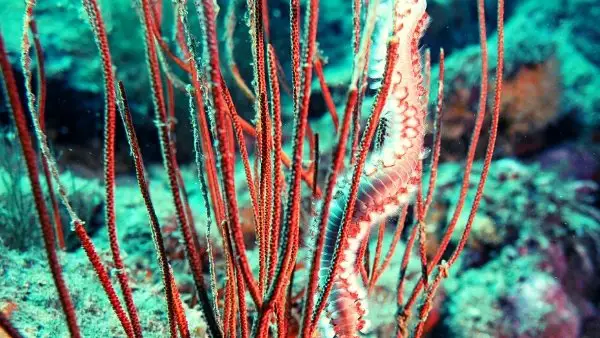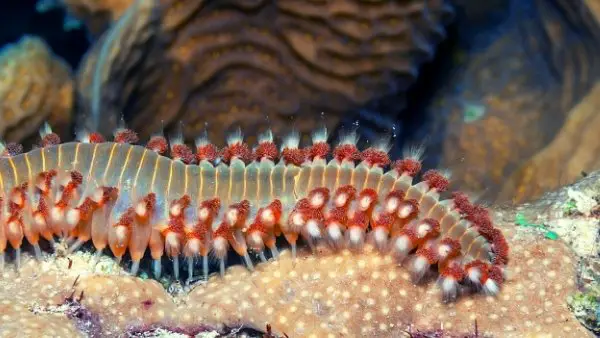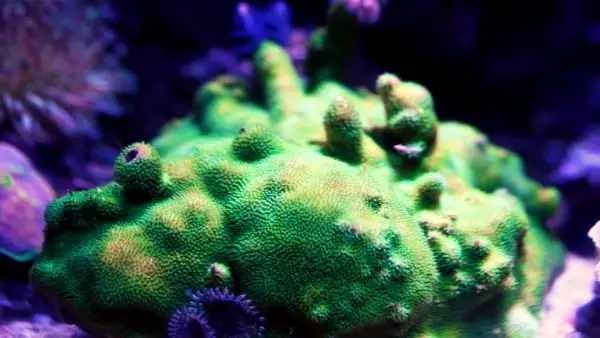Discovering unwanted critters in your tank is an alarming but all too common feeling for hobbyists, especially those with matured and established aquariums. Usually, hitchhikers will be found in a tank that has a lot of life and has been around for a while. Typically, when you find and identify one residing in your tank it is not always a bag thing, in fact, many of them can bring much benefit to your tank and community.
These tank hitchhikers will typically come in the form of worms, snails, shrimp, algae, and anemones, to name just a few. The majority, however, can be be useful additions to your aquarium, cleaning out harmful bacteria, feeding on leftover foods that can dirty up your tank, and even breaking down detritus. So, it is advised to firstly identify the hitchhiker you have discovered, and then choose the most appropriate action to take.
Bristle Worm & Bearded Fireworm Hitchhiker Information
In this guide we will be discussing the best and most humane ways to remove the more harmful hitchhikers, and more specifically, the Bearded Fireworms. We also provide advice on how to remove the extremely commonly found Bristle Worm.
The Bristle Worm, however, can actually bring some benefit to your tank, much like their Spaghetti Worm counterparts, breaking down detritus from your tank free of charge, but some people will just want rid of them regardless as, in all fairness, they were never invited into your community anyway!

Not only this, but Bristle Worms have been known to sting fish and corals with their bristles, and they are certainly not the prettiest critter to grace aquariums, so it is totally understandable why you would want to get rid of them.
The issue with the Fireworm is that its sting is much worse than the Bristle Worms, they are also incredibly aggressive by nature and will likely prey on your clean-up crew, corals, and even small fish.
How Do They Appear?
A very sensible and common question that is constantly posed by hobbyists is “how did I get Bristle Worms? So, the way in which these annoying critters manage to enter your tank is by “hitchhiking” on live rock, coral, plants, and other things of a similar nature that you introduce to your tank that may have been exposed to them.
They find hiding spots within live rock or anywhere else they can hide from the naked eye. They will typically come out at night or when it is dark, so it is difficult to notice them. If you have an established tank and you are overfeeding your fish, expect to see a large spike in numbers, and that is likely when you will start noticing them in their masses.
How Quickly Do They Reproduce?
A lot of hobbyists have no idea what they are, and certainly how they got there. It feels honestly like a total mystery when you find them, and the problem is that they reproduce at an excessive rate, so discovering them early and taking action always a good thing.
Over time they will grow in confidence, which isn’t particularly great for your community as that is when the problems tend to arise. Changing your aquariums feeding pattern and maybe adjusting the amount you feed, in addition to manually removing them is a good idea.
Scientific Name - Polychaeta (Marine Organisms)
Polychaeta is the scientific name for both Bristle and Fireworms. The name is Latin for “Many Bristles”, which is incredibly fitting for these bristly worms, the bristles themselves resemble needles and encompass the majority of these worms’ bodies. They tend to be a pink-red color and are only tiny to begin with, but can certainly grow, and they grow quickly, reaching many inches in length.
When you are purchasing live rock and corals from a store, at times it can be impossible to find every worm that is residing on them due to their tiny size.

How To ID & Remove The Hitchhikers
Now that you know some more basic information about them and also their behavioral patterns when they are in your tank, let's look at identifying and removing them!
Identifying Bristle Worm & Fireworm Hitchhikers
You can identify them fairly easily, Bristle Worms are probably the most common of the two types, and they look exactly how they were described above. They can range in length but will typically look the same. If you discover a worm that looks similar to a Bristle Worm, the chances are it probably is one.
Fireworms are incredibly similar, however, you can definitely tell the difference with relative ease. Check out the images provided below; we have a side-to-side comparison with each worm labeled so that you can use this for future reference.

Fireworms will have a darker back and are usually brighter than the pink/red colored Bristle. During your journey as a hobbyist and aquarium owner, you will definitely run into a Bristle Worm, however, it is fairly unlikely to see a Fireworm, but still a possibility.
How To Prevent Tank Hitchhikers
So, obviously this article is predominantly about removing these unwanted critters from your aquarium and community, however, if you could simply prevent them arriving to your tank in the first place that would be just as useful, right? Prevention is sometimes better than having to take removal action. Here are some suggestions for when you purchase coral and live rock:
- Use dry dead rock and make sure to cycle your tank in order for it to include the beneficial bacteria that will break down the organic matter, doing this will ensure you have a far less chance of seeing these worms appear, and as an added bonus you will also reduce the chance of aiptasia, nudibranch, mojano, and other harmful critters from appearing.

- If you are purchasing ocean-harvested live rock, then wear gloves and use tweezers to remove any worms that you discover before placing in your tank. As a rule of thumb, you should always check anything you place in your aquarium thoroughly.
- The last option is to use a quarantine tank, much like a mating tank, purchase or use a pre-existing smaller tank with no occupants to keep recently purchased live rock or coral and monitor over a few days to see if any critters appear before introducing to your aquarium. This is one of the easiest options to undertake and you don't need to spend a lot of money on a 5-gallon tank (for example).
How to Remove Fireworms and Bristle Worms
Here are the best options for removing these pesky little critters:
- Using tweezers to manually remove them is a good option, however you must wear gloves in case a bristle catches your hand. Also, these worms tend to only expose some of their bodies, so you may end up removing only part of the body – they will regenerate whatever body part is removed (including their heads) so make sure both pieces have been removed.
- Using predators to remove them by treating them as a tasty snack is a good idea, if you already have one of the below fish then that is great. If not, then consider purchasing Dottybacks, Wrasses, or Coral Banded Shrimp to do the job for you. Make sure that these suggested fish are compatible with the fish already residing in your tank.
- You can purchase one of the following Bristle Worm traps, SR Aquaristik Universal Trap, ISTA Clear Glass Trap, Alattin 8 Hole Catcher, TT Gadgets 3D Printed Bristle Worm Trap. Or alternatively, you could make a trap yourself, there are several tutorials on YouTube, with much of the materials readily available on Amazon. Use a piece of the leg from pantyhose with some bait (preferably meaty), the Bristles will get caught up in the pantyhose and then you can pull it out with the worms trapped within it.

Conclusion
In conclusion, having these critters appear in your tank is somewhat of an inevitability, and it is entirely up to you how you want to dispose of them, or if they are Bristles, whether you want to keep them!
Our favorite method, and the most humane, is by having predatory fish eat them, not only are you providing your fish with a sustainable meal source, but you are not having to do any of the dirty work yourself!
Another strong recommendation if you do not want to see these critters would be to follow the prevention advice provided. You must remain aware of the threat these critters pose in terms of infiltrating your tank, they are incredibly sneaky, and will often enter your tank flying under the radar.
Bristle Worms are all-in-all pretty harmless and also provide much benefit to your tank, which is why many hobbyists keep them in, Fireworms, on the other hand, are a different story, and must be removed as soon as you discover them.
